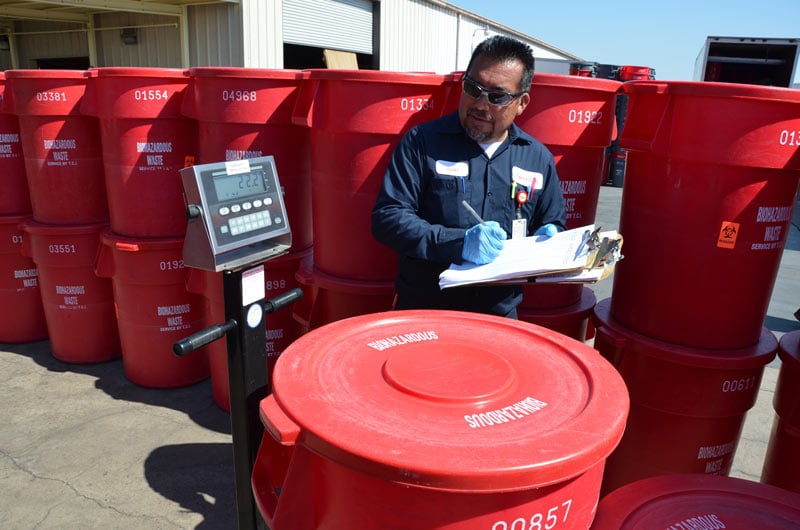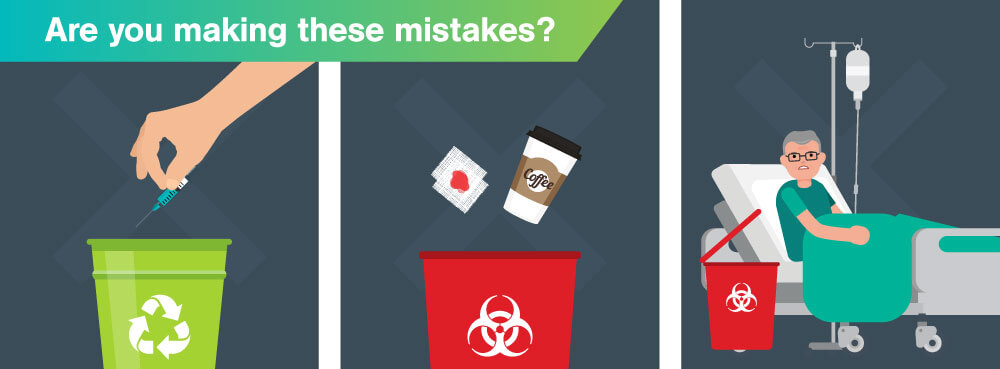Strategic Medical Waste Disposal Solutions: Encouraging Safety and Sustainability
Wiki Article
Best Practices for Medical Waste Monitoring
Medical waste monitoring is an important aspect of health care centers' operations to guarantee the safety and security of patients, staff, and the atmosphere. Applying best methods in clinical waste monitoring is important to lessen the threats associated with dangerous waste. This consists of correct partition and classification of waste, ensuring its safe storage and labeling, adhering to governing guidelines, and using efficient disposal techniques. By following these best techniques, healthcare centers can reduce the capacity for infections, injuries, and air pollution created by improper handling and disposal of clinical waste. This introduction intends to provide an overview of the value of finest methods for clinical waste administration and the succeeding areas will look into each technique thoroughly - medical waste disposal.
Partition and Classification
In the field of medical waste monitoring, appropriate segregation and classification are important practices for making sure the safe and efficient disposal of healthcare-related products. Clinical waste is created from different sources, consisting of medical facilities, facilities, laboratories, and various other healthcare facilities. It is composed of a vast range of things, such as needles, syringes, bandages, handwear covers, and pharmaceutical waste.Segregation involves the systematic splitting up of various kinds of clinical waste based on their attributes and possible risks. Sharps waste, such as blades and needles, ought to be put in puncture-resistant containers to avoid injuries and the spread of transmittable diseases.
Classification is the procedure of classifying medical waste into different categories based upon its possible risks. These classifications may include transmittable waste, dangerous waste, pharmaceutical waste, and basic waste. By categorizing waste, health care facilities can figure out the proper disposal techniques and guarantee conformity with local policies and guidelines.
Appropriate segregation and classification of clinical waste not only safeguard the health and wellness of medical care employees and the basic public however additionally add to the overall performance and effectiveness of waste monitoring. It reduces the threat of crashes, lessens ecological influences, and advertises liable waste disposal practices.
Proper Storage and Labeling
To guarantee the safe and reliable disposal of medical waste, health care facilities need to abide by correct storage and labeling techniques. WasteX Medical Waste Disposal. Correct storage space and labeling play an important role in preserving the honesty of clinical waste monitoring systems and safeguarding the health and wellness and safety of healthcare employees, people, and the publicWhen it comes to storage space, it is important to have actually designated areas specifically designed for different kinds of clinical waste. These areas need to be protected, well-ventilated, and outfitted with suitable containers that satisfy governing standards (medical waste disposal). Partition and categorization of waste ought to likewise be thought about to prevent cross-contamination and prospective hazards

Regular surveillance and inspection of storage space locations and containers are vital to determine any issues or offenses. Personnel ought to be educated on correct storage space and labeling practices, emphasizing the relevance of conformity with policies and protocols.
Safe Transportation and Handling
Ensuring the proper and safe and secure transport and handling of clinical waste is critical for preserving the honesty of waste monitoring systems and guarding the health and wellness of all involved. Clinical waste, that includes products polluted with contagious products, drugs, and other hazardous compounds, must be transported in a way that prevents leaks, spills, and possible contamination.To achieve secure transportation and handling, numerous best techniques should be complied with. It is vital to use watertight and puncture-resistant containers that are specifically created for clinical waste. These containers should be appropriately secured and classified to avoid any type of unintended exposure or mishandling. Furthermore, waste must be set apart based on its nature and type to stop cross-contamination.
During transportation, it is crucial to make certain that waste containers are securely attached and kept in a steady fashion. Automobiles used for carrying medical waste ought to be geared up with appropriate security features, such as spill control systems, to minimize the risk of any kind of leaks or spills. Chauffeurs need to get training on correct handling and emergency situation reaction procedures to successfully deal with any type of unpredicted incidents.
Additionally, the transport and handling of clinical waste must abide with all appropriate policies and standards set forth by neighborhood, state, and federal authorities. WasteX Medical Waste Disposal. medical waste removal service. Routine evaluations and audits need to be conducted to examine compliance and recognize any learn this here now type of areas for improvement
Conformity With Regulatory Standards
Maintaining compliance with regulative standards is necessary for efficient clinical waste management. These standards are put in area to protect public health and wellness and the setting by guaranteeing that medical waste is properly taken care of, dealt with, and disposed of. Compliance with regulatory standards aids to stop the spread of infectious illness, decrease possible risks, and lower the general impact of clinical waste on the setting.To achieve compliance, health care centers must stay notified regarding the details regulations controling clinical waste management in their jurisdiction. These laws may vary from nation to nation, and also within various states or areas. It is essential for health care facilities to have a thorough understanding of these standards and to carry out ideal techniques and protocols to ensure conformity.
One trick element of conformity is the correct segregation and labeling of different kinds of medical waste. This includes dividing sharps from various other waste, as well as classifying waste based upon its potential threats. Medical care facilities have to additionally guarantee that medical waste is kept in proper containers and that these containers are appropriately identified and secured.
Moreover, conformity with regulative guidelines calls for healthcare facilities to develop proper training and education and learning programs for employee entailed in medical waste administration. This consists of providing training on waste partition, managing, and disposal treatments, in addition to the proper use individual safety devices.
Routine surveillance and audits are additionally vital to make sure continuous conformity with regulative standards. This involves conducting routine examinations of waste storage areas, recording waste administration procedures, and keeping records of garbage disposal.
Efficient Disposal Approaches
Health care centers have to utilize reliable disposal techniques for proper administration of clinical waste. Improper disposal of medical waste can present severe wellness and environmental dangers. There are numerous techniques that can be made use of to efficiently throw away medical waste, making certain the safety and security of health care employees, patients, and the public.One commonly used approach is incineration. Incinerators can securely shed medical waste at high temperatures, minimizing the quantity and destroying any kind of potentially harmful virus. Incineration can be pricey and may launch hazardous pollutants into the air if not effectively managed.
One more approach is autoclaving, which entails subjecting the waste to high-pressure heavy steam. This process eliminates germs, infections, and other microbes, providing the waste risk-free for disposal in regular waste streams. Autoclaving is a environmentally friendly and reliable method, but it needs specific equipment and trained personnel.
Chemical sanitation is additionally used sometimes, where liquid chemicals are applied to the waste to decontaminate it. This technique is much less frequently made use of as a result of worries about the efficiency of chemical disinfection and the possibility for chemical residues to contaminate the atmosphere.
Along with these approaches, healthcare facilities ought to likewise execute correct segregation, packaging, and labeling of clinical waste to guarantee its risk-free handling and disposal. Regular training and education and learning of team on correct waste administration practices are critical to preserving efficient disposal techniques.
Final Thought
Finally, applying ideal practices for medical waste management is important for guaranteeing the safety of health care employees, clients, and the setting. By correctly setting apart and categorizing waste, keeping and identifying it properly, making certain risk-free transport and handling, abiding with regulatory standards, and employing effective disposal methods, healthcare centers can properly manage and decrease the risks connected with medical waste. It is crucial for healthcare companies to prioritize and adhere to these ideal techniques to maintain a lasting and risk-free healthcare setting.Clinical waste monitoring is a critical element of health care centers' operations to guarantee the safety and security of patients, personnel, and the environment. Executing finest practices in medical waste monitoring is crucial to minimize the dangers linked with dangerous waste. These classifications may consist of infectious waste, hazardous waste, pharmaceutical waste, and general waste.In final thought, implementing finest practices for clinical waste administration is vital for ensuring the safety of healthcare employees, individuals, and the setting. By correctly classifying and setting apart waste, storing and identifying it appropriately, making sure risk-free transportation and handling, conforming with regulative guidelines, and utilizing efficient disposal approaches, healthcare centers can properly manage and decrease the threats connected with medical waste.
Report this wiki page